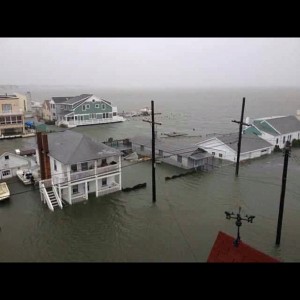By Tim Zatzariny Jr.
For OCNJ Daily
Jack Ball bought his house at 10th Street and the bay one week before Superstorm Sandy made landfall just north of Ocean City on Oct. 29, 2012.
He and his wife had not even moved in before the storm hit.

“To be honest, I didn’t expect this to still be standing here,” Ball said in a recent interview on his property.
Living on the bay in the shadow of the Route 52 causeway provides Ball with a dock for his boat and a serene view of the water. But calling a flood-prone area home isn’t without its lingering problems.
Although it suffered only minor roof damage during the storm, Ball’s house didn’t escape Sandy’s lasting impact. Two years after Sandy struck the island, Ball is one of many Ocean City residents still dealing with the storm’s aftermath. They’re now asked to navigate a swirl of grant programs, applications, shifting regulations, surveys and contractors.
Ball is raising his 1,800-square-foot, gray-brick veneer home by six feet. The work is being done as the city plans to raise 10th Street near the bay to mitigate flooding. Ball is also raising the portion of the bulkhead that runs along his property to eight feet, to match what the city’s doing with the public portion of the bulkhead.
“It has to bee a cooperative effort to hold the water back, or it’s all for nothing,” Ball said.

Many homeowners affected by Sandy find themselves in a morass: Raise their homes to meet new elevation standards set by the Federal Emergency Management Administration or see their flood-insurance premiums potentially skyrocket (read more). The standard is known as base flood elevation, and it represents the hypothetical level floodwater could reach during a 100-year storm. A local ordinance requires another two feet to be added to base flood elevation.
Neither Ocean City nor the state forces homeowners to elevate their homes unless the building is newly constructed or is substantially reconstructed (with project costs exceeding 50 percent of a structure’s assessed value).
Elevating a home is complex and expensive process, even for an experienced builder and real estate agent like Ball. To get the project started, he had to fill out a mountain of paperwork, plus hire an engineer and an attorney to help him navigate the process.
“For the normal homeowner, the process is very complicated,” said Ball, 59. I can’t imagine people who don’t know how to do this process getting through it.”
In summer 2013, Ball applied for a $30,000 elevation grant through New Jersey’s Reconstruction, Rehabilitation, Elevation and Mitigation (RREM) program http://www.renewjerseystronger.org/rrem/, which provides federal funding to help homeowners repair or rebuild homes affected by Sandy. He didn’t receive approval for the grant until May of this year, and started the elevation project in October. He hopes to be back in the home next month, with the project completed early next year.
At least a half dozen other homeowners in Ball’s neighborhood are raising their homes. This is a sign of things to come not just in Ocean City, but also all along the Jersey coast, he said.
“I believe that at some point, we’re all going to have to raise these houses, or pay through the nose through flood insurance,” said Ball, who is chairman of the Ocean City Historic Preservation Commission. “If you don’t raise them, they’re going to make flood insurance unaffordable, and you won’t be able to sell the home down the road.
Ball estimated he’ll spend $100,000 to elevate his home, but said that price is on the low end. J. Ball General Contractors of Egg Harbor Township, a company owned by Ball’s son, John, is doing the elevation work on the home.
“If I had (an outside) contractor doing this, it would be $150,000 to $175,000,” Jack Ball said.
Through the RREM program, New Jersey has distributed a total of $7.5 million so far to 105 homeowners in Ocean City for repairing and rebuilding homes affected by Sandy, said Lisa Ryan, a spokeswoman for the state Department of Community Affairs, which oversees the program. The agency does not track the number of elevation grants separately from grants for other types of recovery work, she said.
Once the elevation on his home is complete, Ball will see his annual flood-insurance premium drop from $620 per year to about $200 annually. While the savings are negligible, raising his home will allow Ball to add to it something he felt was lacking: a multi-car garage.
Elevating a house goes something like this: Workers dig holes around a home’s perimeter, then push steel beams underneath. A hydraulic system using jacks raises the beams in unison, lifting the house at its floor joists, 12 inches at a time. Then, the workers build “cribs” (wooden structures that look like stacked pallets) around the jacks, adding more blocks with each lift. The cribs provide resistance for the jacks as they raise the house into the air.
Jack Ball’s home will eventually be lowered onto its elevated foundation.
When he’s done raising his father’s home, John Ball will do the same for a bungalow across the street.
“After Sandy, we ran around six days a week doing repair work, and most of it was knee-jerk,” he said. “But people are starting to realize things are going to have to change, or the same things are just going to happen again.”
John Ball, 30, saw first-hand the havoc a major storm can wreak in a coastal town. Two Laura’s Fudge Shop locations owned by him and his sister, Katie, in Ocean City were seriously damaged by floodwater during Superstorm Sandy.
“Before the storm, everybody took hurricane warnings in stride,” John Ball said. “I think Sandy caught a lot of people off guard.”
——
OCEAN CITY RECOVERY BY THE NUMBERS
- To date, 218 eligible Ocean City homeowners have submitted applications for assistance through the RREM Program. (the RREM Program provides grants for rehabbing, reconstructing, elevating and mitigating homes affected by Sandy.)
- Of the 218 eligible homeowners who applied, 176 have been preliminarily approved for funding in RREM. Of these, 105 have signed grant awards with RREM Program, with the state obligating a total of $14.25 million to their rebuilding, elevation and mitigation efforts.
- A total of $7.5 million has been disbursed to these 105 homeowners to reimburse them for eligible construction costs already incurred and/or to fund remaining construction costs, which include everything from pulling permits and repairing damage to elevating structures and obtaining temporary and final certificates of occupancy.
(Source: New Jersey Department of Community Affairs)
__________
Sign up for OCNJ Daily’s free newsletter and breaking news alerts
“Like” us on Facebook





